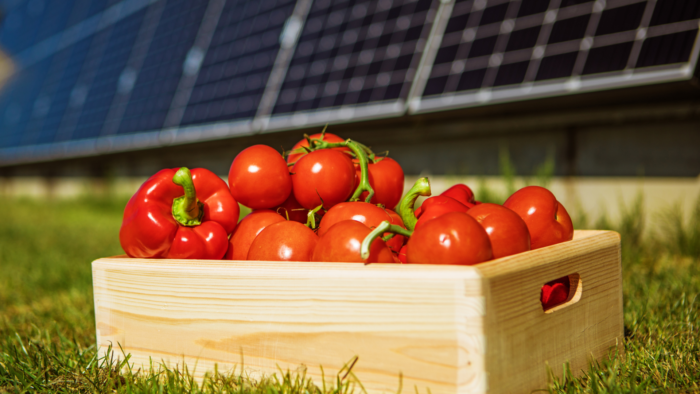What if the food on your plate came from the same place that powers your community? Agrivoltaics is changing how solar farms are constructed to better serve communities.
One major critique of solar farms is that they use land that could be utilized for farming. And we agree with the feelings behind that – we should definitely be making the most of our land while ensuring the protection of local wildlife and a positive impact on the community. We take any chance to work with developers that advocate building solar arrays on brownfields, landfills, and unusable land for solar farms. With agrivoltaics, solar farms are sustainably integrated into agricultural life providing further benefits to the community that extend beyond supplying it with clean energy.

Pollinator planting agrivoltaic solar farm
Table of Contents
What is agrivoltaics?
Agrivoltaics is the combination of solar energy and agriculture, giving it the potential to tackle our ability to provide locally available food and energy for expanding populations. In the face of increasing populations and rising global temperatures, we need to strategically use our land to boost both energy resilience and food production to meet our rapidly growing needs. We have almost 8 billion people on Earth that all need to eat and have access to electricity.
When combined, solar and agriculture form a symbiotic relationship where both provide benefits for the other. There are three types of agrivoltaics that all help tackle our food production challenges in different ways:
Pollinator Planting Agrivoltaics
Pollinator planting agrivoltaics involves growing pollinator-friendly wildflowers to support the local pollinators, which include butterflies, bats, bees, beetles, and other insects that are crucial to our ecosystem. Did you know that pollinators are responsible for bringing us one out of every three bites of food? Most flowering plants rely on the help of pollinators to reproduce and pollinator populations across the globe are shrinking. Beekeepers in the United States have lost around 30% of their colonies every year since 2006. By combining solar with pollinator-friendly plants, developers can help support these vital animals essential to getting food on the table.
The great state of Minnesota created its Habitat Friendly Solar Program to support the establishment of habitats for pollinators, songbirds, and other species to provide technical guidance for projects, including small community solar projects and utility-scale projects. The co-benefits of these practices include water management, grazing, and soil health. Programs like these are important in helping developers, customers, and other stakeholders plan their projects sustainably.
Another perk of planting vegetation around solar panels is water conservation. Deep-rooting plants help mitigate storm water runoff and there are five Georgia solar sites currently being tested for storm water infiltration and runoff. Another pollinator agrivoltaic study from the University of Illinois will use their findings to create a pollinator planting manual, cost-benefit calculator, native seed mix selection tool, and pollinator assessment tool. These will be vital resources for developers as agrivoltaics become the norm in the solar industry.
Animal Grazing Agrivoltaics
Animal grazing agrivoltaics involves putting livestock on the same land used for the solar farm. The animals consume the grass grown underneath the panels while also using the solar panels for shade when it’s extremely hot and sunny. The grass under the panels reduces the temperature of the panels during the day and reduces heat loss at night, which improves the performance of the solar panels.
This is an ideal solution when the soil is unsuitable for growing crops but can still provide a home for a pasture and adorable sheep to thrive. Adding a solar array to the same land used for grazing also provides an additional revenue stream for farmers. This is a win for their wallets and a win for the environment!

Crop Production Agrivoltaics
This type of agrivoltaics involves growing crops underneath solar panels. Some crops have even been shown to grow better under panels. Research from Chonnam National University in South Korea proved that broccoli develops a deeper shade of green due to the shade provided by the panels, making it more appealing to consumers without compromising crop size or nutrition. The shade from the panels caused the broccoli to retain more moisture, which resulted in a deeper hue.
Farmers in Vermont successfully grew saffron around solar panels by planting them in the aisles and at the edges of a solar array. Crops that grow well under panels can vary with the local climate and quality of soil, so we’re excited to see more research in the future that will help farmers and developers work together to design dual-use solar arrays that produce energy while successfully growing regional crops.
Believe it or not, the term “Agrivoltaics” was only coined in 2011. Being just over a decade old means that there are plenty of research opportunities in the field that will help developers, farmers, and other stakeholders plan more consciously and sustainably when siting solar arrays. While clean solar energy helps mitigate climate change, agrivoltaics shows us that there’s an incredible amount of opportunity to be more thoughtful and eco-conscious through our work.




